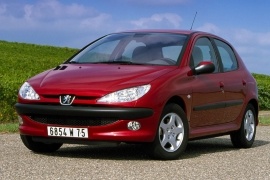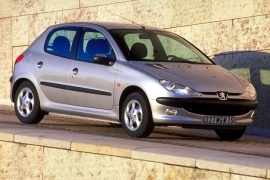PEUGEOT 206 5 Doors Models/Series Timeline, Specifications & Photos
First production year: 1998
Engines: Gasoline, Diesel
Body style: Hatchback
The 206 was an instant hit for the French carmaker, even though its customers were still missing the old 205. In 2002, the carmaker introduced a mild facelift that increased sales.
Changing a cult-car was never easy for any carmaker. But Peugeot dared to do that when it replaced the 205 with the 106 and the 206. While the former was mostly a city vehicle, the latter proved to be successful as a commuter vehicle, and it faced a huge success among women.
The 2002 facelift was mostly on the technological side. The exterior featured the same feline headlights and black plastic molds on the bumpers and on the sides. These were highly appreciated since they didn't need any repairs after shopping-carts bumps or parking in too-tight spots. Some minor changes appeared on the front bumper and the taillights. Also, depending on the trim level, the car featured body-colored door handles or just plain black.
Inside, the carmaker introduced new materials for specific trim levels and a new design for the instrument cluster. They featured a silver ring around the dials, and that enhanced the driving experience. The carmaker adjusted the pedals to be easily driven by women who wore high-heels. It was a true innovation for any carmaker. While men couldn't find a proper driving position in any aspect, women found it easier.
Under the hood, Peugeot introduced new engines that made the car more fuel-efficient. It offered the 1.4-liter turbodiesel developed together with Ford and adjusted all of its range to the Euro 3 pollution norms.
Peugeot found it hard to replace the old and loved 205, but it had to do it. The car was old, and some customers already chose other brands.
The 205 was built between 1983 and 1998 and it was considered a special vehicle. In its latest years on the market was built only for enthusiasts, and its sales volumes were already small. The 306 was not convincing and the 106 was too small. The car that made the enthusiasts forget about the 205 was the 206.
With a sharp-looking design, feline-like headlights, and short hood, the 206 stormed the European market. Peugeot 206 was the new contender ready to head-on with the Fiesta and the Polo. The 206 appeared on the market in three and five doors versions. The raked windshield, small cabin, and curved lines immediately attracted attention.
Inside, the curved line's theme continued on the dashboard. Behind the steering wheel, on a separate controller, the car featured the audio controls. The car was charming, but the driving position was difficult to get for taller drivers, who had to drive with bent knees and straight arms. But the car was a real four-seat vehicle, and the extra doors in the back were just a confirmation for that. The trunk was decent for a family, but the spare-wheel had to be installed under the car, in the back.
Peugeot offered the 206 with a wide choice of gasoline and diesel engines that offered between 60 hp and 138. The sportiest version was reserved for the three-door body.

